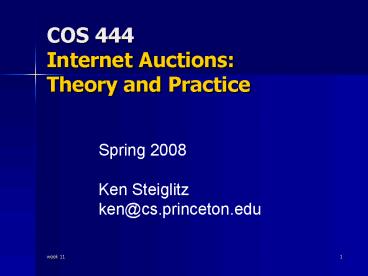COS 444 Internet Auctions: Theory and Practice - PowerPoint PPT Presentation
Title:
COS 444 Internet Auctions: Theory and Practice
Description:
See Richard Thaler's The Winner's Curse: Paradoxes and Anomalies of Economic ... In the laboratory the Winner's Curse is real and persistent ... – PowerPoint PPT presentation
Number of Views:71
Avg rating:3.0/5.0
Title: COS 444 Internet Auctions: Theory and Practice
1
COS 444 Internet AuctionsTheory and Practice
Spring 2008 Ken Steiglitz
ken_at_cs.princeton.edu
2
Winners Curse
- The paradigmatic experiment bid on a jar of
nickels - The systematic error is to fail to take into
account the fact that - winning may be an informative event!
- Caused by a cognitive illusion
- See Richard Thalers The Winners Curse
Paradoxes and Anomalies of Economic Life,
Princeton University Press, 1992.
3
(No Transcript)
4
Winning is bad news, unless you shade
- Suppose bidders are uncertain about their values
Vi , receiving noisy signals Xi - Based on this information, your best estimate is
EV X1 - Suppose you, bidder 1, win the auction!
- Then your new best estimate of your value is EV
X1 , Y1 lt X1 lt EV X1 --- where Y1 is the
highest of the other signals
5
Example first-price auctions
- Common-value model say the item has the same but
unknown value to all bidders, and each bidder
receives a noisy signal related to the true value - Suppose the number of bidders increases. Then
- According to the private-value
equilibrium, you should increase your bid - Taking into account the Winners Curse, you
should decrease your bid (often dominates)
6
Winners curse, cont
- Important paper, which describes how to find a
symmetric equilibrium - R.B. Wilson, Competitive Bidding with Disparate
Information, Management Science 15, 7, March
1969, pp. 446-448. - That is, how to compensate for the tendency to
forget how likely it is for winning to be bad news
7
Empirical results
- In the laboratory the Winners Curse is real and
persistent - Observed in practice oil industry, baseball free
agents, book publishing - Even professional bidders from the commercial
construction industry succumb (Dyer at al.
suggest they learn situation-specific rules
rather than the right theory Thaler, p. 56 ) - What do you do if you find your competitors are
making consistent errors? Publish! Thaler, pp.
61-62, after Julia Grant
8
- Capen et al.s fortune cookie
- He who bids on a parcel what he thinks it is
worth, will, in the long run, be taken for a
cleaning.
9
Interdependent Values
- In general, we relax two IPV assumptions
- Bidders are no longer sure of their values (as in
the common-value case discussed in connection
with the Winners Curse) - 2) Bidders signals are statistically
correlated technically positively affiliated
(see Milgrom Weber 82, Krishna 02) - Intuitively if some subset of signals is large,
its more likely that the remaining signals are
large
10
Major results in Milgrom Weber
- For the general symmetric, affiliated- values
model - English gt 2nd -Price gt 1st -Price Dutch --
(revenue ranking) - If the seller has private information, full
disclosure maximizes price --(Honesty is the
best policy)
11
Milgrom Weber Caveats
- Symmetry assumption is crucial results fail
without it - English is Japanese button model
- For disclosure result seller must be credible,
pre-committed to known policy - Game-theoretic setting assumes distributions of
signals are common knowledge
12
The linkage principle (after Krishna 02)
- Consider the price paid by the winner when her
signal is x but she bids as if her value is z ,
denoted by W ( z , x ) - Define the linkage
- Sensitivity of expected price paid by winner to
variations in her received signal when bid is
held fixed
13
The linkage principle , cont
Proposition Two auctions with symmetric and
increasing equilibria, and with W(0,0) 0, are
revenue-ranked by their linkages. Consequences
1st -Price linkage L1 0 2nd -Price price
paid is linked through x2 to x1
so L2 gt 0 English through all signals to x1
so LE gt L2gt L1































